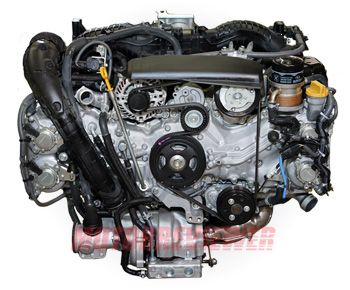Subaru FA24F 2.4L Engine Specs, Problems, Reliability, Info

Subaru 2.4L Turbo FA24F Overview
The FA24F, also known as the FA24DIT, is a 2.4-liter, four-cylinder turbocharged boxer engine with direct fuel injection. The first vehicle to receive this 2.4L turbo engine from FA family was the 2019 model year Subaru Ascent mid-size crossover SUV. Subaru currently uses the FA24F in many popular models such as the Outback and Legacy, as well as in sports vehicles, the WRX and Levorg. So, is the engine good or bad? What are its pros and cons? Let's take a closer look at this motor.
FA24F Engine Design
The engine is build around an open-deck aluminum cylinder block with cast-in iron cylinder liners. Compared to the previous 2.0-liter FA20 engine, the cylinder bore has been increased from 86 mm (3.39 in) to 94 mm (3.7 in). The piston stroke didn’t change. The FA24F features the same style of connecting rods as the FA20DIT (so-called diagonally split connecting rods). New pistons have a larger diameter. The FA24 also comes with aluminum DOHC heads with dual AVCS system. The camshafts are driven by single roller timing chains (one on each side). The valve train features roller rocker arms and no hydraulic lash adjusters. The valve covers are made from plastic.
Unlike the naturally aspirated FA20 and FA24D engines, which feature combined direct and port fuel injection (Toyota D-4S), this engine only has a direct fuel injection. This means that fuel is only injected into the combustion chambers. A high-pressure fuel pump is still attached to the left cylinder head and is driven by the intake camshaft. In addition to direct injection, a twin-scroll turbocharger Garrett MGT2260Z has been added to the engine. The intake system features an air-to-air intercooler type, a plastic intake manifold, and an electronic throttle body. The FA24F also comes with a stock liquid-to-liquid oil cooler (the FA20DIT don’t have that).
The main goal was to achieve performance similar to that of a 6-cylinder naturally aspirated engine. And Subaru's engineers managed to do it. The new 2.4-liter direct injected and turbocharged boxer engine produces up to 271 hp and 277 lb-ft, which is comparable with most available NA V6s, and it makes it on regular fuel.
Engine Specs
Oil recommendations and capacity may vary depending on the car model, year, and market. Please check the service manual specific to your vehicle!
FA24F Problems and Reliability
The FA24F engine has been on the market for some time, but so far, there have not been any major problems with it. But of course, there are no perfect engines, and this motor also has some cons.
- FA24F engines only have direct fuel injection, so carbon builds up in the intake ports and on valves, which need to be cleaned mechanically every 50,000-60,000 miles or so.
- The longevity of DI system components, such as the high-pressure pump and injectors, is highly dependent on the quality of the fuel.
- Use only the engine oil recommended by the manufacturer. Otherwise, the timing chain and sprockets of the cam phaser adjusters will wear out quickly.
- The FA engines are known to generate a lot of heat. Keep cooling radiator clean and check your fluids occasionally.
Reliability Summary
How good is the FA24 engine? It's been in the Ascent, Outback, and Legacy for a while and is also in the current Subaru WRX. Seems to be a solid engine so far. At least, it's definitely far more reliable than the predecessor, the FA20DIT. Proper care is essential for long-term reliability. So, follow the maintenance schedule and regularly check the fluids. The average lifespan of the FA24 engine is approximately 200,000 miles (300,000 km).
